 Allied losses by the end of the day
Allied losses by the end of the day
22 April 1915: 24.00
Lost Ground
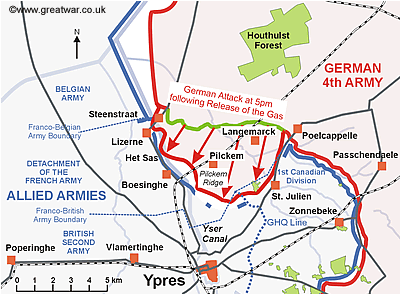
By midnight on 22nd April the German infantry had breached the Allied front line between Steenstraat and the Franco-British Boundary forming the Canadian left wing. Between the Canadian left wing and the Yser Canal there were dangerous gaps in the Allied line, which the Allies would have to stop up. The German advance had penetrated deep into Allied territory. On the left of the British line near St. Julien the left wing and rear of the 1st Canadian Division was dangerously exposed. The way to Ypres was open and the German infantry would doubtless try to push on to Ypres the next day.
Allied Casualties and Losses
French Artillery Losses
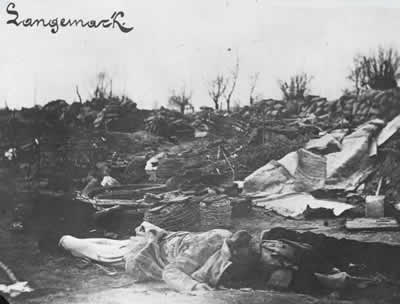
|
A French Army report stated that the French lost 11 gun batteries to the enemy. By 7pm all the French field guns had fallen silent. The 90th Brigade, which had been the brigade on the French 45th Algerian Division front at the time of the attack, lost all five of its gun batteries, which included one battery of 4 heavy 120mm guns. The total number of French artillery guns lost is given as 55, compared to the 51 claimed by the German Official History. This may be because the French recovered the 4 heavy 120mm guns in subsequent fighting on 25th April. The French detailed the losses of 22nd April as follows(1):
- 29 x 90mm guns (from 87th Territorial Division sector)
- 6 x 95mm guns (from 87th Territorial Division sector)
- 4 batteries i.e. 16 x 75mm guns (from 45th Division sector)
- 1 battery i.e. 4 x heavy 120mm guns (from 45th Division sector)
French Infantry Losses
During the French withdrawal about 1,800 French infantrymen, who were not overcome by the gas or who could escape towards the rear French area, were taken prisoner. About 200 of these were seriously affected by the gas and treated by the Germans. Most prisoners were sent back to the rear German area and the Houthulst Forest. The Medical Officer of the 1st African Battalion was trying to withdraw to Pilckem from the front line when he was captured. His account is as follows:
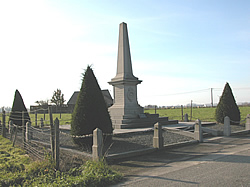
|
“I was able, under a hail of bullets, to go as far as the railroad line. The latter however was being shelled with terrific precision. I tried to follow the road, but it too was being heavily shelled. I then decided to retreat across the fields, but after less than a hundred metres my route was blocked by barbed wire. I was able to cross the barbed wire network by creeping along a ditch, but I had lost a lot of time and suddenly saw the Bosches only fifteen metres ahead of me. They were calmly marching along, rifles slung over their shoulders. One of them saw me and took aim, but even at that short distance missed me. What luck! Other Bosches motioned me to move to the rear. Damn, I was a prisoner!
I passed German columns moving up to the attack. In their midst they carried huge panels with various inscriptions which probably served to signal the infantry's positions to their artillery. Following the soldiers about to attack I also saw men carrying gas cylinders. All of them wore protective masks over their noses. Together with a group of prisoners we were herded into the forest of Houthulst.” (2)
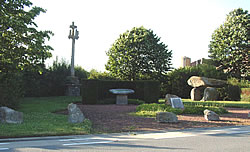
|
A French Army report gave a figure of about 600 casualties who had not been killed or taken prisoner but had been gassed and were no longer fit to fight.(3)
French and Belgian Battlefield Memorials
A memorial to the soldiers of the French 87th Territorial Division and 45th Algerian Division stands at the “Carrefour de la Rose - Rose Crossroads” junction about 1 kilometre west of Pilckem village on the road between Langemarck and Boesinge.
A simple memorial cross made of aluminium stands on the west side of the Ypres-Yser canal at the village of Lizerne. This memorial is dedicated to the French troops who faced the gas attack on 22nd April 1915.
A memorial to the Belgian Grenadiers who held the line on the west bank of the canal is located north of Lizerne.
British Artillery Losses
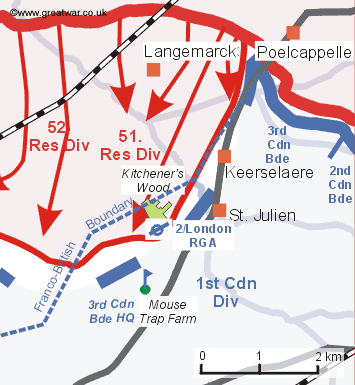
Four British heavy 4.7" guns were located in the south-west part of Kitchener's Wood, north-west of St. Julien. They were the 2nd London Battery of the Royal Garrison Artillery (2/London RGA on map). As the German infantry of 51. Reserve Division arrived at the wood the British gunners fought a rearguard action with the 7 rifles they had to defend themselves. This, however, gave them time to remove the firing pins and the breechblocks which were taken back to safety behind the British positions. The guns were captured by the Germans.
British Infantry Losses
The 1st Canadian Division bore the brunt of the German attack on the left wing of the British line. At the time of the attack each Canadian battalion was at the strength of approximately 30 officers and 950 men.
On 22nd April 1915, according to the Canadian Official History(4), the number of casualties (killed, died of wounds, wounded, missing presumed dead and prisoners) for the 1st Canadian Division was 642 by the end of the day. Some of the casualties included in this figure are, however, believed to have been killed or wounded in the early hours of the next day, 23rd April, particularly in the case of 2nd Canadian Battalion. This battalion went into action after moving up from the reserve just after midnight on 22nd April, but its casualty figure has been included in the total for the 22nd April.
- Total casualties for 3rd Canadian Infantry Brigade was 177:
- 13th Battalion: 3 officers and 42 other ranks
- 14th Battalion: 1 officer and 16 other ranks
- 15th Battalion: 1 officer and 24 other ranks
- 16th Battalion: 3 officers and 87 other rank
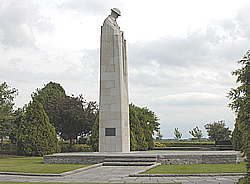
|
Lieutenant Guy Drummond, aged 27 was the son of the Honourable Sir George Drummond, KCMG, and Lady Drummond of Montreal. He was killed while trying to rally French troops who had joined the men of his 13th Battalion. His body was also reburied after the war in Tyne Cot British Military Cemetery, grave reference LIX.B.28.(7)
- Total casualties for 2nd Canadian Infantry Brigade was 147 (7 officers and 122 other ranks of these were from the 10th Battalion. This battalion's figures are listed on 22nd April because it went into action in the counter-attack on Kitchener's Wood just before midnight on that day).
- Total casualties for 1st Canadian Infantry Brigade was 297 (239 of whom were other ranks from 2nd Battalion, which did not in fact go into action until the early hours of 23rd April).
- Total casualties for 1st Canadian Divisional troops was 7.
- Total casualties for 1st, 2nd and 3rd Canadian Field Artillery Brigades was 9.
Confusion and Disruption for the Allies
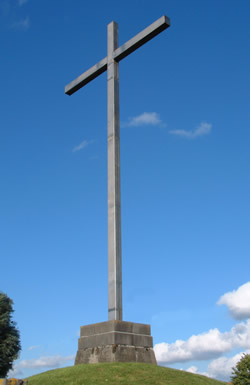
|
The hasty withdrawal of the two French infantry divisions - 87th Territorial Division and 45th Algerian Division - had unavoidably caused confusion; French units were mixed up and the command and control structure was displaced. By the end of the day there were only weak French units south-east of Boesinghe and a mixture of French and Canadian troops north of St. Julien.
The busy activity in the rear areas of the Ypres Salient that night is described in the Official History of the Canadian Forces 1914-1919:
“All through the night the roads were thronged with vehicles, batteries on the move, cyclist orderlies, ammunition column wagons replenishing dumps of S.A.A., battalion transport taking up rations and water, and ambulances clearing the wounded.” (8)
Movement of troop reinforcements and ammunition under cover of darkness into the north part of the Ypres Salient was constantly disrupted by the German artillery firing on Ypres and all roads leading out of the town.
Over the next few hours before daybreak of 23rd April thousands of French and British troops marched in silence through the dark landscape of the Ypres Salient into the battle zone, their silhouettes lit up by flaming buildings and exploding German shells.
Next>> German gains by the end of the day
Related Links
For the location of the memorials to the gas attack on 22nd April and other memorials and monuments in the Ypres Salient see the listing at:
Monuments in the Ypres Salient
Canadian Memorial at Vancouver Corner
Acknowledgements & Notes
(1) Les Arméées Françaises dans la Grande Guerre, Tome II, Troisième Partie, Chapitre XV, p. 700.
(2) From Le Drame sur L'Yser by Colonel J J Mordacq, quoted in Gas! The Battle for Ypres, 1915, p. 49
(3) Gas! The Battle for Ypres, 1915, p. 56
(4) Official History of the Canadian Forces in The Great War 1914-1919, Appendix 851
(5) See the page 13th Battalion responds to the German attack
(6) and (7) See the pageTyne Cot British Military Cemetery
(8) Official History of the Canadian Forces in The Great War 1914-1919, p. 244
Photograph (private collection) of the French casualty at Langemarck courtesy of Bridgeen Fox.